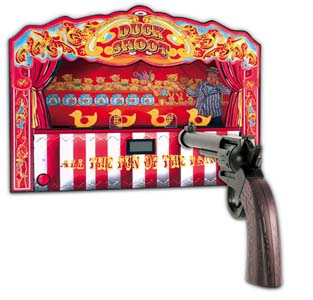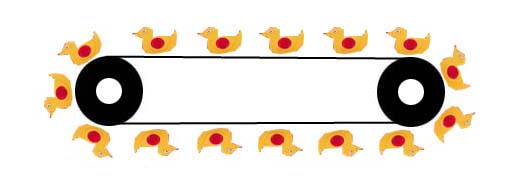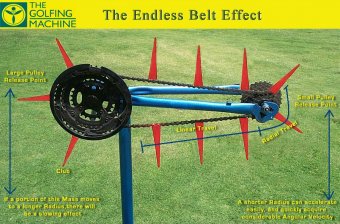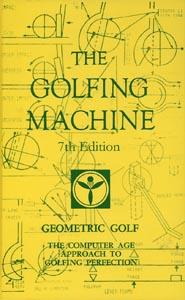Understanding the Club Release Phenomenon - The Endless Belt Concept
Click here to go to the index page.
Introduction:
This review paper is devoted to the topic of the biomechanics/mechanics of the "club release phenomenon" in golfers, who are swingers (and not hitters). The term "club release" refers to the release of power accumulator number 2 (PA#2) during the mid-late downsing, where the left wrist uncocks so that the clubshaft can become straight-in-line with the left arm at impact (or low point). In a swinger's action, the release of PA#2 is passive, and not due to any active uncocking action of the left wrist. The club release phenomenon is a centrifugal release phenomenon and it occurs according to the basic laws of physics. However, an important question becomes - how can a golfer optimise the centrifugal release action so that he can square the clubface at impact? Many beginner golfers have an inefficient club release action and the club is not released completely by impact - this results in an open clubface at impact and the end-result is weak pushed/push-sliced shots. I think that if a golfer understands the biomechanical/mechanical swing factors that contribute to an efficient club release action, then he can modulate his swing accordingly. Homer Kellley, the author of the TGM book [1], came up with an interesting conceptual analogy - the endless belt concept - that can help a golfer better understand the club release phenomenon. He described the "endless belt" concept very briefly in his book, and many ardent TGM-students, who have spent years studying different TGM-concepts, admit that they could never clearly understand the endless belt concept. I will discuss the endless belt concept in great detail in this review paper, so that any interested reader can clearly appreciate the usefulness of the concept in getting to better understand the biomechanics/mechanics of the club release phenomenon.
The endless belt concept:
What is an endless belt? An endless belt is simply a conveyor-style belt that goes around two pulleys at either end of the endless belt system.
Consider a duck-shooting gallery that can be found at a carnival fairground.
Model of a duck shooting gallery
In a duck-shooting gallery, the shooter fires bullets at the ducks that are moving at a steady speed across the front of the fairground stall. The feet of the ducks are attached to a conveyor belt with a hinge-mechanism, and if the bullet hits the duck it flops over at the hinge-mechanism. The ducks are moving at a steady speed because the conveyor belt is moving at a constant (controllable) speed.
Duck shooting gallery's endless belt system
The above diagram shows the fundamental construction of a duck-shooting gallery's endless belt system. Note that there is an endless belt that revolves continuously around two end-pulleys.The ducks are either traveling along the straight-line section of the endless belt system, or they are traveling around the pulley section, at which time their travel direction can be perceived to be in a radial direction (along a circular path that has a fixed radius, which is dependent on the size of the end pulley).
Consider another variation of an endless belt system.
Endless belt system - adapted from reference number [2]
John Furze has created this model of an endless belt system using a bicycle chain that revolves around the pedalling chainring (large pulley) and the cogs of a rear bicycle axle (small pulley). He has "fixedly" attached red linear objects to the bicycle chain, and those objects can be conceived to be equivalent to a golf clubshaft. In his model, the red objects are always at a 90 degrees angle to the chain because their foot-attachment is fixedly/rigidly attached to the chain. If a person rotates the large pulley counterclockwise, then one can imagine an endless belt system that is analogous in operation to the duck-shooting gallery's endless belt system.In this endless belt system, one can observe that the foot-end of the red object (equivalent to the grip end of a clubshaft) travels at the same speed as the head-end (equivalent to the clubhead end of a clubshaft) when the chain moves along the straight line section of the endless belt system at a steady speed. However, when the chain moves around the pulley section of the endless belt system at the same steady speed, then the head-end of the red object (equivalent to the clubhead end of a clubshaft) must be moving faster than the foot-end (equivalent to the grip end of the clubshaft) - it has to be moving faster in terms of surface speed because it is further away from the center of the axis of circular rotation. The other important point is that the difference in surface speed between the head-end of the red object (equivalent to the clubhead end of a clubshaft) and the foot-end (equivalent to the grip end of the clubshaft) is greater when the chain moves around the smaller pulley (compared to the larger pulley). Conceptually, one can conceive of a "force" being present that makes the head-end of the "clubshaft" move faster than the foot-end, when the foot-end is obliged to move in a radial/circular direction, rather than a straight line direction - and we can label this "force" a "centrifugal force". The idea of a "centrifugal force" becomes more logically rational if I modify John's model in the following arbitrary manner.
Endless belt system - personally modified from the photo obtained from reference number [2]
In this endless belt system, I have made a few personal modifications. I have attached the "clubshaft" (represented by the pink linear object) to the chain with a hinge-joint apparatus (represented by the blue-colored object). Imagine that this hinge-joint has a small amount of controllable friction that allows the "clubshaft" to be suspended at an acute angle relative to the chain (and that the amount of friction is just enough to overcome the force of gravity). When the "clubshaft" is moving along the straight-line section of the endless belt system in a counterclockwise direction (between point 1 and point 2), then the acute angle between the "clubshaft" and the chain will remain unchanged if the chain moves at a slow steady speed that doesn't jerk the foot-end of the "clubshaft" by imparting any sudden acceleration/deceleration forces. However, when the chain moves at the same steady speed around the small end pulley of this endless belt system (between point 2 and point 3), then the acute angle between the "clubshaft" and the chain will steadily increase due to the presence of a "centrifugal force". That "centrifugal force" will allow the head-end of the clubshaft to eventually catch-up to the foot-end of the clubshaft (at point 4). In other words, the "force" that allows the head-end (equivalent to the clubhead end of the clubshaft) to catch-up to the foot-end (equivalent to the grip end of the clubshaft) is a "centrifugal force", and that force only exists because the hinge-apparatus travels in a radial/circular direction. Conceptually, the hinge-apparatus can be conceived to be equivalent to the "left wrist" and the chain's direction of travel can be conceived to be equivalent to the direction of travel of the end of the left arm (left hand arc). This endless belt system concept allows one to visually/mentally picture the physical functioning of the release of PA#2 in a swinger's action. In a swinger's downswing action, the left arm/hand (with the clubshaft angled back at an acute angle of <90 degrees relative to the left hand arc) is swung in space in a direction that is mainly downwards in the direction of the ball. If the end of the left arm (left hand) travels in a radial/circular direction, then a "centrifugal force" is passively/automatically/naturally created that will allow the clubhead end of the clubshaft to catch-up to the grip end of the clubshaft (without any need for any active left wrist uncocking action).Consider the movement of the left hand in space (left hand arc path) in a left arm swinger's downswing action.
Jamie Sadlowski's left hand arc path during his downswing - from his swing video [3]
The red colored path represents the path of the hands during the downswing - produced by the spline tool in my V1 Home swing analyser program. One can see that the hand path has a circular, or U-shaped appearance. Position 1 is the position of the hands at the end-backswing position. Position 2 is the position of the hands at the end of the early downswing. Position 3 is the position of the hands at the end of the mid-downswing. Position 4 is the position of the hands at the end of the late downswing (impact).If one first looks at Jamie Sadlowski's downswing hand arc path, it may appear to be mainly circular/elliptical in shape, and one may not be able to relate the hand arc path to the mental image of the "endless belt concept", where the belt path has a straight section and also a radial/circular section, where the belt goes around an end-pulley. However, the following revised photograph should help one to mentally perceive the hand arc path differently.

Jamie Sadlowski's hand arc path in relationship to the endless belt concept
I have superimposed a faint image of the endless belt pulley system over the photo of Jamie Sadlowski in such a manner that the straight line section of the endless belt is parallel to the "straightish section" of Jamie's hand arc (between point 1 and point 2) and the hands should be perceived to moving in a linear fashion between point 1 and point 2. The end-pulley section of the endless belt (where the hands are moving in a radial/circular fashion) should be perceived to primarily exist between point 2 and point 3. The hands should then be perceived to exit the main end-pulley section at point 3, and be traveling in a less "tight" radial fashion between point 3 and point 4. The hand arc path between point 3 and point 4 can be perceived to be equivalent to an end-pulley section where the end-pulley's radius is very large, so that it doesn't contribute as much centrifugal force to the club release phenomenon (compared to the section between point 2 and point 3). If one understands these points, then one should imagine that the hands are traveling at roughly the same constant speed in the late phase of the early downswing and mid-downswing, and that the centrifugal force (that causes the club to release) primarily becomes operant between point 2 and point 3 because the hands are traveling in a radial/circular direction. Note the abrupt change of direction of the hands when the hands reach point 2. This is the time-point that the hands are entering the end-pulley section of the hand arc. Note that Jamie's clubshaft has a large amount of lag when it reaches point 2, and that it has far less lag by the time it reaches point 3 - because the club is being centrifugally released with a large amount of centrifugal force during this time period of travel around the end-pulley. The centrifugal force causing the club to release produces enough release-force to catapult the club "around the corner", and the club will continue to centrifugally release between point 3 and point 4. The club is <50% released by point 3, and most of the club release's angular range-of-travel occurs between point 3 and point 4. However, the amount of energy needed to complete the centrifugal release between point 3 and point 4 is far less than the amount of energy needed to centrifugally release the club between point 2 and point 3 - because the club has already gained a large amount of angular momentun by point 3. To better understand this point, consider an analogy - the waterskier analogy.Waterskier analogy.
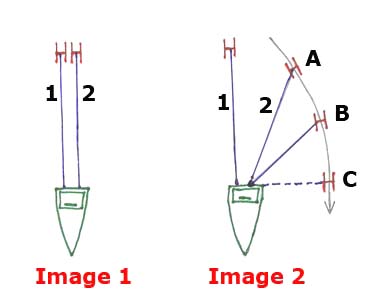
Waterskier diagram
Imagine two waterskier's being pulled by a speedboat that is traveling at a constant speed in a straight line direction. Image 1 shows that the two waterskiers will travel at the same speed as the speedboat if they angle their skis so that they travel in a straight line - directly in-line with the speedboat's linear travel in a straight line direction. Image 2 shows what will happen if one of the waterskiers (skier 2) angles his skis so that he travels in a circular arc. As skier 2 angles his skis sideways at an angle to the direction of travel, he will acquire angular momentum so that he travels faster than skier 1. By point A, he will be traveling faster than skier 1, and it takes a lot of "force" to cut across at that angle. Eventually, skier 2 can build up enough angular momentum to catch up to the speedboat - point C. The amount of energy required to go from point B to point C will be less than the amount of energy required to go from point A to point B - because the skier is constantly acquiring angular momentum due to his circular direction of travel. The same principle applies to the club release phenomenon in a golf swing - once the golf club starts being centrifugally released, it acquires angular momentum, and that acquired angular momentum allows the clubhead to achieve progressively greater surface speed with progessively less need for additional centrifugal-release energy input.Consider Jamie Sadlowski's swing again.

Jamie Sadlowski's hand arc path in relationship to the endless belt concept
The size of the end-pulley affects the "tightness" of the hand arc turn as the hands move from point 2 towards point 3 in the mid-downswing. A small end-pulley is an end-pulley that has a small radius, and which produces a "tight" hand arc turn, while a large end-pulley has a large radius that produces a more gradual hand arc turn. The most important learning-fact that a reader needs to understand is that the size of the end-pulley (and "tightness" of the hand arc turn) that occurs between point 2 and point 3 is primarily determined by the angle of approach of the hands as they reach point 2 - the angle of approach of the straight line section (between point 1 and point 2) relative to the radial section (between point 2 and point 3). The hands always travel in a relatively "straightish" manner (more precisely, a circular path having a larger radius) in the direction of the target between point 3 and point 4, and the critical angle that affects the magnitude of the centrifugal release force is the angle of approach of section (1-2) relative to section (2-3). To make this point even clearer, consider the following diagram.
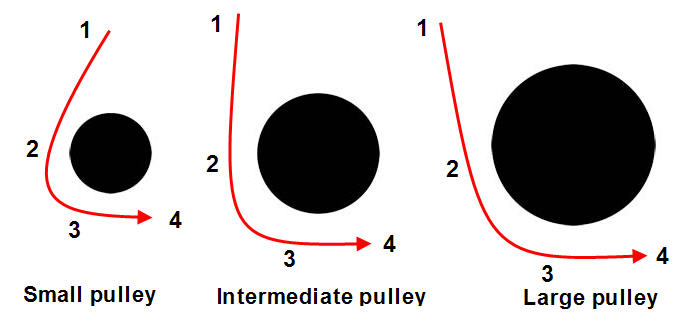
Three hand arc paths based on pulley size
The first example shows a small pulley, where the straight-line section between point 1 and point 2 approaches the lowest section of the hand arc curve from slightly left-of-vertical, and that creates a tight" hand arc curve between point 2 and point 3. The second example shows an intermediate-sized pulley, where the straight-line section between point 1 and point 2 approaches the lowest section of the hand arc curve from a vertically-oriented approach (as if the hands are dropping vertically down from their end-backswing position to point 2), and that creates a moderately "tight" hand arc curve between point 2 and point 3. The third example shows a large pulley, where the straight-line section between point 1 and point 2 approaches the lowest section of the hand arc curve from slightly right-of-vertical, and that creates a "gradual" hand arc curve between point 2 and point 3.The small pulley's hand arc curve is going to create to the largest amount of centrifugal release force (per unit time), while the large pulley's hand arc curve is going to produce the least amount of centrifugal release force (per unit time) - during the time period when the hand arc path is radial/circular in nature. Most professional golfers use either a "small pulley" hand arc curve or an "intermediate-sized pulley" hand arc curve, and they are more likely to use a "small pulley" hand arc curve when using driver/woods/long irons, which have a wider clubhead arc - therefore requiring a greater amount of centrifugal force to ensure that the club release phenomenon is fully completed by impact. When using a short iron, professional golfers will more likely use a hand arc curve pattern that is closer in pattern to an intermediate-sized pulley's hand arc curve pattern. A large pulley size's hand arc pattern is a hand arc pattern where the distinction between the straight-line hand arc section and the radial/circular hand arc section is indistinct and not discrete. The entire hand arc path can then be perceived to be more rounded in shape throughout the early-mid downswing path of travel, and it can be perceived to be entirely a "large-radius" circular path from top-to-bottom of the downswing. It will cause a more gradual club release starting from the top-of-the downswing, and it will predispose to a sweep release (a club release phenomenon where the club releases slowly and smoothly throughout the downswing, and where there is no sense of "cracking a whip" as occurs in a late snap release action). Beginner golfers, who start the downswing with an out-of-order kinetic sequence, by first pulling their hands downwards-and-forwards towards the ball in a wide rounded arc, will more likely generate a large pulley's sweep release pattern. Professional golfers may also deliberately use a large pulley's sweep release pattern for finesse control - when hitting half-shots (less than full swing shots) in the distance range of 30-100 yards. For maximum swing power, and maximum driving distance when using their driver, professional golfers (who are swingers) will more likely use a small pulley's "tight curve" hand arc path. How do they create that "small pulley" hand arc pattern, where the hand arc path in the early downswing is downwards and slightly backwards (hands are directed away from the target)? Why do the hands move slightly away from the target during the early downswing?
Re-consider Jamie Sadlowski's downswing.
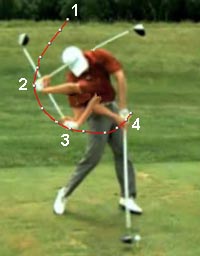
Jamie Sadlowski's downswing hand arc pattern - from his swing video [3]
The early downswing ends when the left arm is parallel to the ground (point 2). During the early downswing, the hands move downwards, but also backwards (away from the target). Why? The "correct" answer lies in understanding that the phenomenon is due to "correct" kinetic sequencing.

Jamie Sadlowski's early downswing action - capture images from his swing video [3]
The "correct" kinetic sequence in a left arm swinger (like Jamie Sadlowski) should start from the bottom-up - at the start of the early downswing, the lower body (pelvis) rotates first and then the upper body (shoulders) rotates secondarily. There is no active/independent pulling of the grip end of the club by the left hand during the early downswing. During the early downswing, the shoulders rotate perpendicularly around the rightwards-tilted spine, and during this rotational motion they are rotating relatively horizontally. The left arm is pulled forwards by the rotating left shoulder socket, and the right arm is pulled backwards by the rotating right shoulder socket, and the arms/hands/clubshaft move at the same speed as the rotating upper torso (rotating shoulders). Look at the range of motion of the left/right shoulder sockets between image 1 and image 4 in the above composite-photo. Note that the hands rotate counterclockwise to exactly the same degree as the upper torso - because the left arm is not rotating faster than the upper torso rotation. If the upper torso's counterclockwise rotation is relatively horizontal, then the two hands' rotation must be relatively horizontal, and the hands must move away from the target (while also moving downwards due to the fact that the spinal axis of rotation has a slightly rightwards tilt). In other words, the straight line section of the hand arc path between point 1 and point 2 is due to a "correctly executed" pivot action (a "correct" kinetic sequencing of the downswing's pivot action) where the power package remains intact during the early downswing. The left arm only starts to move faster than the rotating upper torso in image 5, and that represents the start of the release of PA#4. It is at that time-point, that the hands are starting to enter the radial/circular section (section 2-3) of the hand arc path.The same phenomenon can be seen in nearly all professional golfers (who are left arm swingers).
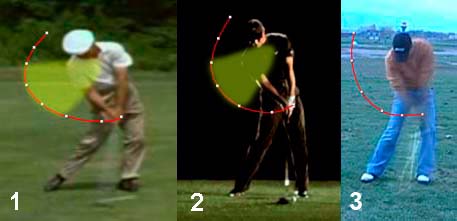
Hand arc path of three golfers - capture images from their swing videos
Note that Ben Hogan (image 1) and Tiger Woods (image 2) have the same basic "tight curve" hand arc pattern as Jamie Sadlowski - note that the hands move slightly backwards (away from the target) in the early downswing. The yellow-colored area represents the "tight" radial/circular section (section 2-3) of their hand arc path, and it is primarily during this mid-downswing time period that the club is being centrifugally released. During this time-period, the left arm is freewheeling towards impact at a steadily-increasing speed. No additional thrust energy should be imparted to the left/right arm during this phase of the downswing. In fact, any attempt to accelerate the hand speed during this "club releasing" phase of the downswing will likely interfere with the centrifugal release action, and slow down the speed of the centrifugally-induced club release action. Some amateur golfers attempt to increase swing speed by applying a push-force with the right arm/hand at this critical juncture of the mid-downswing, and they disrupt the centrifugally-induced release of PA#2. They push the hands/club grip too fast towards impact, and they simultaneously disrupt the smoothness of the centrifugally-induced club release phenomenon (which slows down the speed of club release) => the end-result is a late downswing action where the hands outrace the clubhead by a large margin => hands reach impact far ahead of the clubhead and there is too much forward shaft lean at impact => pushed/push-sliced shots.Image 3 shows Scott's hand arc path - from reference number [4]. Note that it is visually-equivalent to a "large pulley's" hand arc path. However, Scott is a TGM-hitter, and he does not use a swinger's drag-loading action that utilises a centrifugal release of PA#2. A TGM-hitter drive-loads the clubshaft using an axe-handle technique, and there is no centrifugal club release action in a TGM-hitter's swing. A TGM-hitter is applying a constant push-force to the back/aft side of the grip end of the club throughout the entire mid-late downswing. A TGM-hitter attempts to actively thrust his hands in a straight-line thrust direction towards the ball (via the active release of PA#1) and the resultant hand arc path will always have that general "gradual curve" configuration (in contrast to a TGM-swinger who often uses a "tight" hand arc curve path).
Consider the hand arc path and club release pattern of a TGM instructor - Ben Doyle.
http://www.youtube.com/watch?v=bVZ0wY03rjk
Here are capture images from that swing video.

Ben Doyle's hand arc path and club release pattern - capture images from his swing video
Ben Doyle's hand arc path is depicted in red in image 4. Note that the hand arc path is relatively "straightish" and there is no "tight curve" section that can induce a powerful centrifugal release force. However, his hands do move along a circular path (albeit of large radius) in the late phase of his mid-downswing and early phase of his late downswing as his hands pass across the front of his right thigh and that radial hand arc path induces a CF-release - note that his club has released somewhat between image 2 and image 3. Ben Doyle still maintains a significant clubhead lag angle until a very late time-point in his downswing - until his hands are passing an imaginary line between his eyes and the ball (yellow dotted line in image 3). Note that his hands are only a few inches away from their impact location (image 4), and the club releases very fast/abruptly between image 3 and image 4 - this late club release action is called a late snap release. What causes this late snap release if it cannot be due to a passive centrifugal release phenomenon - which requires a circular/radial travel section around an end-pulley? The most likely biomechanical explanation is that it's his "straightening right arm" - straightening right elbow, while the right elbow continues to slide by the right hip area - that applies a push-force via the right palm to the grip end of the club. The right arm may not be straightening in an active straight line thrust manner (as occurs in a TGM-hitter's action), but the right arm must be straightening with enough isotonic force, so that it can successfully induce a complete late snap release of the club prior to impact.Ben Doyle's club release action can be considered to be a non-automatic club release action - in contrast to the automatic club release action (CF-release action) that occur's in a left arm swinger's action when the club goes around the "tight curve" of a small end-pulley section of the hand arc path. A golfer, who uses a non-automatic club release action (like Ben Doyle), can regulate the timing of the club release action via the aiming point technique. When a golfer uses an aiming point technique, he aims his hands at a point that is at the ball, or ahead of the ball, when he starts the downswing. The further forward he aims his hands, the further forward (in the direction of the target) he can get his right elbow, and his hands, before the club eventually snap-releases.
Addendum added Februrary 2010:
I produced an audio commentary for an online golf discusion forum, where I discussed the club release phenomenon in a particular golfer's swing (Mike McNary's swing). The audio commentary may hep you better understand the role of the endless belt concept in the club release phenomenon.
The audio commentary is available as an mp3 file and it should be playable on any media player that can play mp3 files.
http://perfectgolfswingreview.net/AudioMcNaryRelease.mp3
I will be referring to the following 4 images in my audio commentary.Image 1:
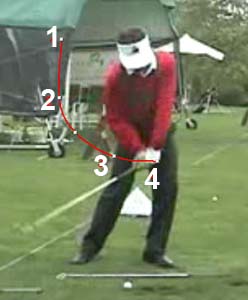
Image 2:

Image 3:

Image 4:

Jeff Mann.
November 2009.
References:
1. The Golfing Machine. Homer Kelley.
2. The Golf Machinist. John Furze.Available at http://www.golfingmachinist.com.au/article.php?id=1
3. Jamie Sadlowski's swing video.
Available at http://www.youtube.com/watch?v=EZ0dNIP-yoU
4. Scott's (TGM-hitter) swing video.
Available at http://www.youtube.com/watch?v=08k4R6SlbZI
